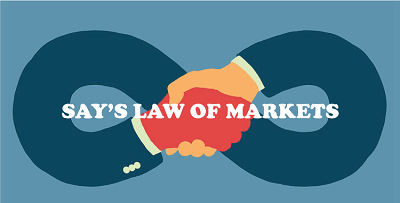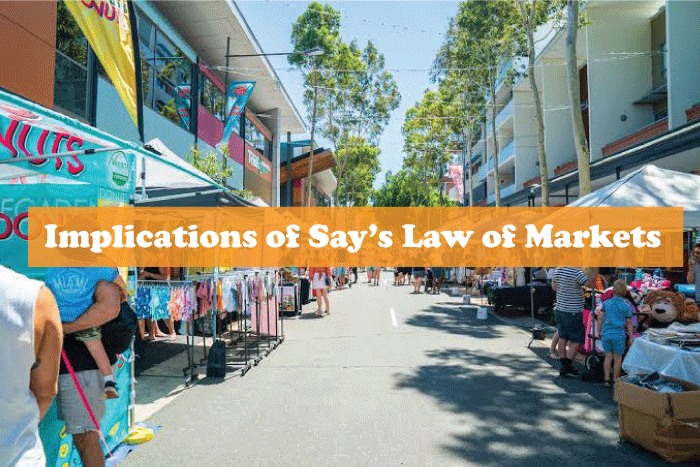Say's Law of Markets Theory and Implications ExplainedWhat is Say's Law of Markets?Say's Law of Markets is a concept from the neoclassical theory that contends that the revenue earned through past production or sales is a prerequisite for the capacity to make a purchase of current demanded production. Say argued that to be able to purchase anything, one must have the ability to produce something (good or service) to offer. Therefore, the output or production is the source of demand rather than money itself. 
According to Say's Law, national policy should stimulate (but not restrict) output rather than encourage demand or promote consumption because output is the key to economic development and stability. According to a traditional economic theory, the money made through the sale and manufacturing of commodities in the past serves as the main driver of current-day demand for goods. Say's Law has seen many revisions and iterations over time by many neoclassical economists, especially modern economists. Understanding the Say's Law of MarketsThe French writer and classical economist, named Jean-Baptiste Say, created Say's Law of Markets in 1803. Say's beliefs in the origins of prosperity in the community and the character of economic activity made him prominent. Say argued that a purchaser must have traded something to have the money to purchase. Therefore, demand is not created by money but rather by the products produced and sold for money. Or, to put it another way, a person's capacity to demand products or facilities from others depends on the revenue generated by their prior acts of output. Say's Law challenged the mercantilist idea that wealth comes from money. According to Say's Law, money only serves as a means of exchange between the valuation of earlier created products and the value of new things as they are created and introduced to the market. The sale of these new items generates money revenue, increasing the demand for later purchases of other goods in a continual round of manufacture and indirect trade. To say, wealth was only a tool for moving actual economic products, not a goal in and of itself. Say's Law states that rather than a lack of money, a lack of a commodity's demand in the present might result from the collapse of the manufacture of other commodities that would have otherwise traded for enough money to buy the new commodity. Say continued by stating that under normal conditions, such shortages in manufacturing some items would be quickly remedied by the promise of profits from such goods. However, he noted that when the manufacturing failure is sustained by a continuing natural catastrophe or (more frequently) political involvement, certain items might remain scarce, among others. Say's Law consequently concurs with the idea that governments should practice laissez-faire economics and refrain from interfering with the free economy. Implications of Say's Law of Markets
Say derived four points from his argument, such as:
Say's Law thus refuted the widely held mercantilist belief that capital is the basis of wealth, that companies' and nations' financial interests are at odds, and that shipments are bad for an economy. Keynesian Criticism of Say's LawSay's Law is based on the principle that states- "supply generates its demand". According to the translation, creating a good alone is sufficient to generate a need for it. Furthermore, full employment cannot be deviated from since the production and total demand for commodities and services will always be equal. One of Say's Law's most influential detractors or critics is John Keynes. According to Keynesians, Say meant that if anything is created, the money made from that output is automatically spent to satisfy consumer demand. He continued to say that Say was wrong and that the concept was not correct because some money (or income) is often also kept for later use or consumption. However, Keynes emphasized a small portion of the intricate theory underlying Say's Law and portrayed it as an entirely new idea of his own. In truth, the law does not deny the possibility of general gluts or recessions, even while it asserts that there cannot be a significant lack of the capacity to buy what has been created (i.e., absence of want for present supply) in the long term. In reality, Say's Law considers the potential of aggregate demand differing from aggregate output given the presence of money. Suppose the banking industry is permitted to operate freely. In that case, the money that some individuals decide to save will be distributed to those who want to lend, reallocating demand while keeping the same aggregate demand. Thus, Say's Law discredits the circular movement of economies. As a result, contrary to Keynesians' criticism, the law of markets is not contradicted by the phenomenon of recession, and the existence of weak aggregate demand is not always caused by market failure. Say's Law as a whole offers insights into how the market functions. Later Economists and Say's LawSay's Law continues to be used in neoclassical economic theories of today, and supply-side economists have been inspired by it. According to the implications of Say's Law, a supply-side economist, in particular, think that tax incentives for firms and other measures designed to boost production without disrupting business operations are the optimal course of action for monetary policy. Furthermore, Austrian economics adheres to Say's Law. Say's acknowledgment of trade and commerce as processes taking place over time, emphasis on specific items rather than aggregates, stress on the startup's role in coordinating economies, and conclusion that sustained declines in economic activity are often caused by government involvement notably compatible with Austrian philosophy. Say's Law was subsequently succinctly (and inaccurately) summed up by economics professor John Maynard Keynes in his 1936 book, called "General Theory of Employment, Interest, and Money", in the now-famous statement, "supply creates its demand", even though Say himself never used that expression. Keynes revised Say's Law to construct his macroeconomic ideas before debating on his own revised version. Despite Say's explicit and continuous focus on the manufacturing and trade of different specific items against one another, Keynes misinterpreted Say's Law as a declaration about macroeconomic aggregate output and spending. Keynes concluded that Say's Law looked to be broken by the Great Depression. Say's Law was modified by Keynes, who said there had been an overall surplus of output and a shortage of demand and that economies may encounter crises that market mechanisms could not resolve. Say's Law's consequences are directly in opposition to the recommendations of Keynesian economics. To increase demand, administrations should utilize comprehensive fiscal policies and money creation, according to Keynesians, because individuals tend to hoard cash during difficult times and liquidity constraints.
Next TopicTax Accounting
|
 For Videos Join Our Youtube Channel: Join Now
For Videos Join Our Youtube Channel: Join Now
Feedback
- Send your Feedback to [email protected]
Help Others, Please Share










